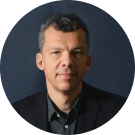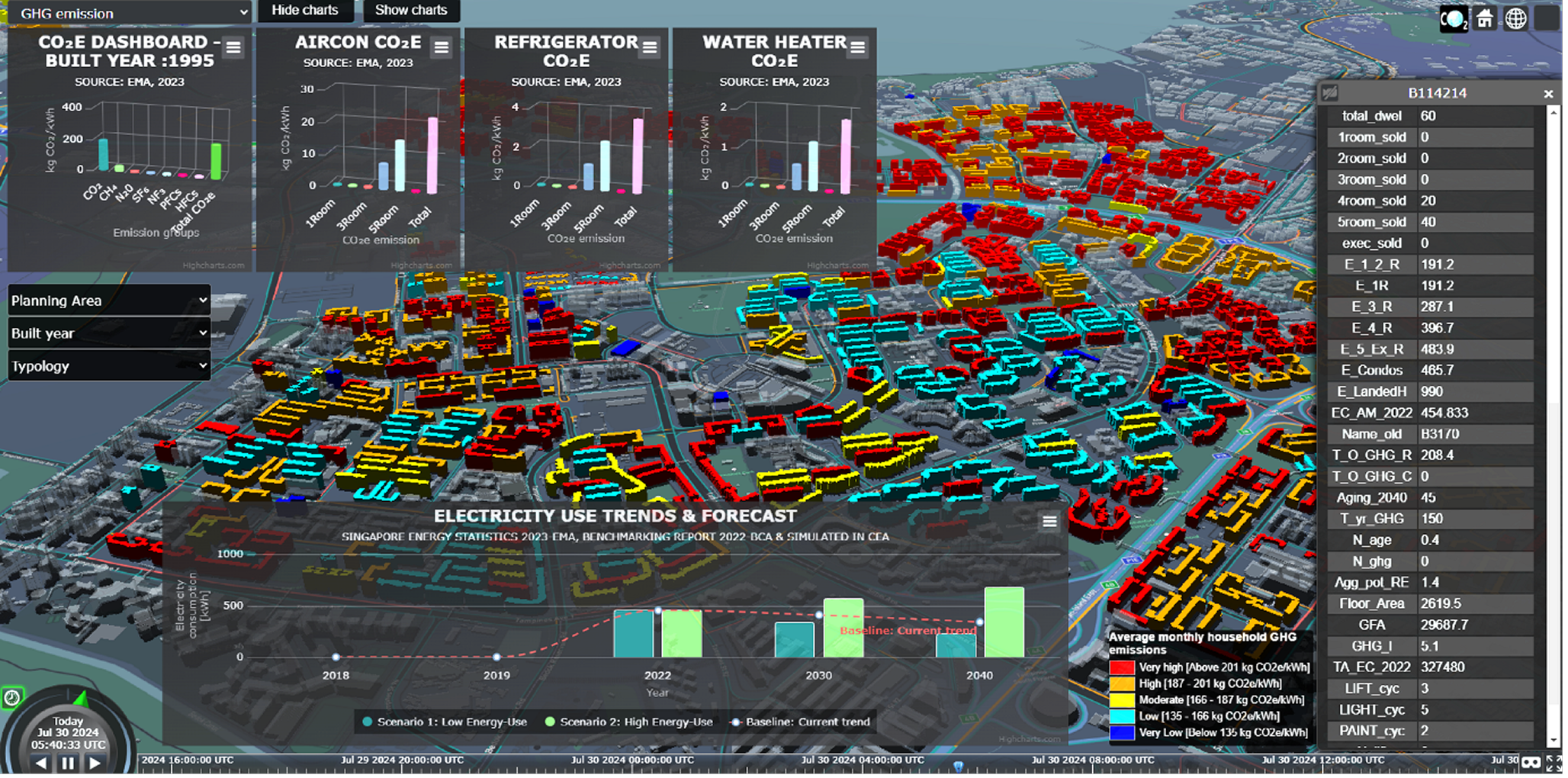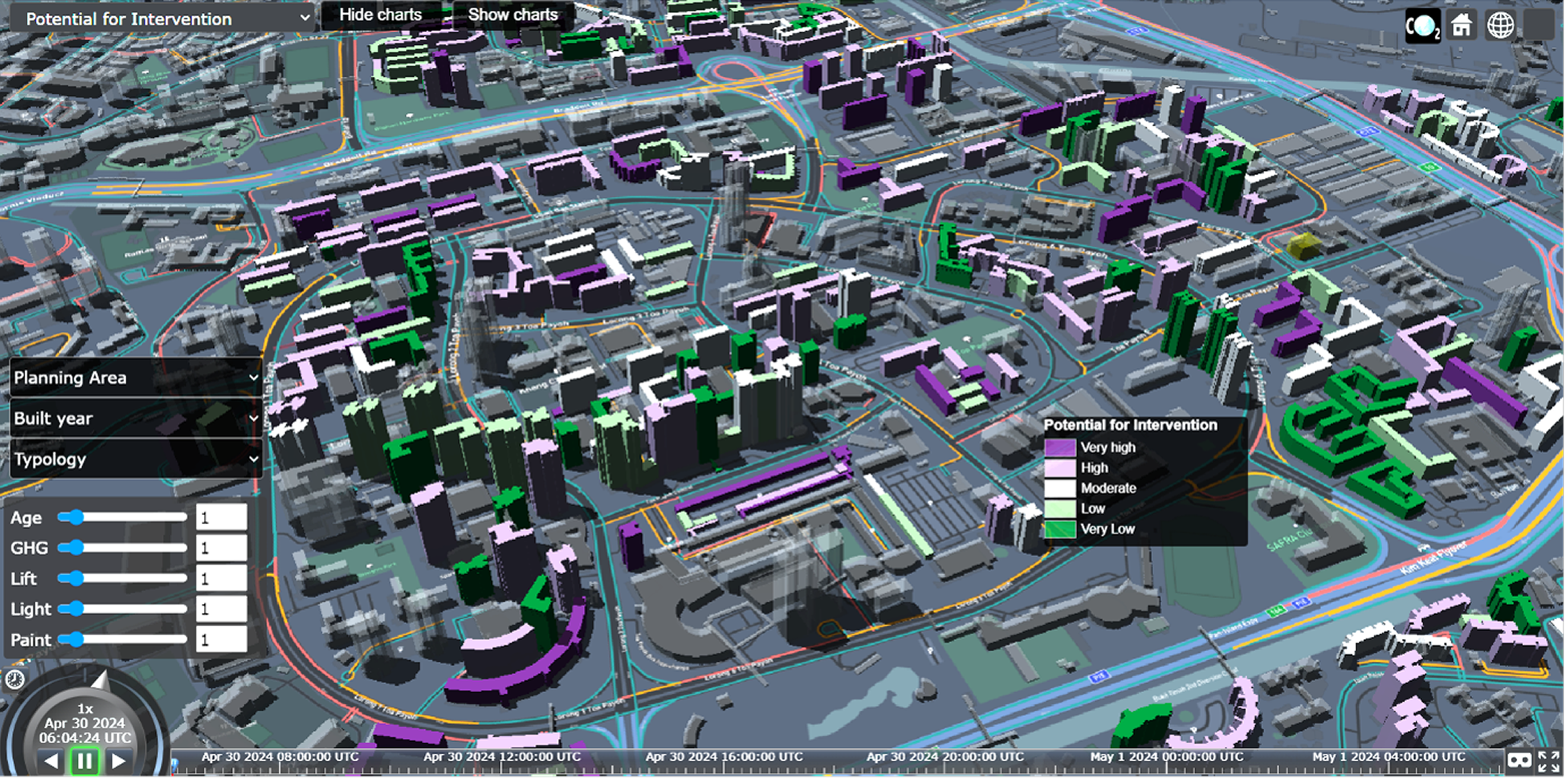Think bigger, think whole: Decarbonising Singapore
As cities invest more in decarbonising the built environment, digital simulations such as Urban Digital Twins are being used more. To enhance long-term urban planning, Pradeep Alva and Rudi Stouffs are studying newer tools using open-access apps and artificial intelligence to create scenarios that are more holistic, and closer to the real world.

Pradeep Alva,
Research Associate at NUS’ Department of Architecture and at the Future Resilient Systems programme at Singapore ETH-Centre, is developing a 3D web map application for decarbonising initiatives for cities.

Rudi Stouffs,
Dean's Chair Associate Professor
and Assistant Dean (Research and Technology) at NUS’ Department of Architecture, is the principal investigator of projects including the “Digital Twin-Enabled System Resilience”.
The concept of an Urban Digital Twin (UDT) – a digital map of a city, used to study scenarios, to facilitate urban planning – serves as a control room environment for short-term city operations. and a policy instrument for long-term planning. Recent examples of UDTs have shown their potential as a tool for decision-making and guiding stakeholders in various domains [1]. But there are only a few demonstrations of UDT in use, and these are mostly specifically built for smart city energy use purposes - this indicates a vital need for more examples and demonstrations in this sector.
Amid the challenges of data collection and the implementation of artificial intelligence (AI) in UDTs, the practicality of the real world is often overlooked. UDTs are simplified representations of the real world, encompassing various theoretical perspectives and reflecting diverse aspects of the actual system. Nevertheless, UDTs can use scenarios to illustrate the actual consequences of human actions, that can help users gain insights into real-world situations. Therefore, providing enhanced user experiences beyond the confines of a control-room setting is crucial, leveraging the collected data to facilitate imperative learning and support problem-solving initiatives.
The objective of our research is to provide actionable insights into the development of UDT with a specific use case for accounting for building greenhouse gas (GHG) emissions. As part of this research, a web-based open-access tool called the GHG App has been developed to aid in smart city management in Singapore. The GHG App is built using a 3D integrated dataset, with open data related to building information and electricity use. The app comes with a robust user-experience dashboard that has input scenarios modelled along with visualisations to read electricity use data and corresponding GHG emissions estimated (shown in Figure 1).

URBAN DIGITAL TWINS
UDTs generally aim to mirror the physical features of a city like its buildings and streets. Many have started to include data like traffic, pedestrian movement, and energy use. Planners, policymakers, and academics hope they can use UDTs to test proposed interventions and predict their impact on the city.
Facilitating real-world case studies
A real-world case study of Singapore has been developed in collaboration and guidance of local government agencies and policy experts [2]. This case study focuses on how to manage the city's ageing residential buildings with a target of decarbonisation.
The GHG App is used to simulate a renovation scenario for public housing in Singapore using a multi-criteria decision analysis (MCDA). A Potential for Intervention (PFI) analysis has been performed, which generates a heat map that indicates the urgency to renovate buildings in a future scenario of 2040 (shown in Figure 2).
The GHG App and PFI analysis can assist decision-makers in prioritising and planning the renovation of low-carbon building systems. The research increases stakeholder awareness by providing:
- A theoretical investigation (methodology for estimating building operational GHG emissions, scenario simulation, and PFI analysis); and
- A practical tool (with open-access use case demonstration) so that more environmental considerations can be taken into account whenever building renovation is done.
In many parts of the world, the built environment sector does not currently have a cap on the amount of GHG it emits. Our research can help establish standards for accounting for operational GHG emissions, setting emission limits, and assessing decarbonisation plans in the built environment sector.

"UDTs can use scenarios to illustrate the actual consequences of human actions, that can help users gain insights into real-world situations"
Educating, creating public awareness, about carbon
There is no doubt that UDTs are powerful simulation tools that are able to simplify complex real-world systems, but they often cannot bridge the gap between theoretical insights and real-world execution. A full understanding of their potential can only be realised if UDTs are actually engaged and interacted with. It is also important to remember that educating a wide audience about GHG emissions is a challenge that can only be met with innovative methods that are accessible to all.
In order to decarbonise cities, new ways of informing the general public about the process should be explored using digital tools. While it is essential to collect data and use AI effectively within the UDTs if insights are to be turned into actionable strategies, engaging users and stakeholders in this process so that insights can be translated into actionable strategies is also crucial. In order to address these gaps, a powerful tool such as an AI-powered conversational agent—ChatGHG—is integrated with the App.
ChatGHG is a custom-built chatbot developed using Delphi AI. It engages users with tailored information about GHG emissions, energy use, resources as well as policy initiatives that are specific to Singapore's context [3]. It guides users through complex topics, from understanding the GHG data on the dashboard to exploring strategies for reducing emissions. As an open-access tool, it bridges the gap between research and public engagement, providing decision-makers and citizens alike with critical insights into energy use and emission reduction.
These innovative features are not only helping users learn, but also actively shaping the future of public engagement in environmental issues. Feedback from GHG App users has demonstrated the effectiveness of digital tools in educating and engaging the public. By leveraging AI, the research is driving meaningful change in the way urban sustainability and public policy are approached.
Future research will continue to enhance these tools, improving their functionality and expanding their use cases. As more AI-driven technologies are integrated into UDTs, the potential for city-wide decarbonisation becomes increasingly achievable. Through the GHG App, the research aims to make climate action accessible and effective for everyone.
Assessing the whole lifespan of buildings
The built environment is responsible for nearly half of global resource usage. However, the current global economy is only 7.2% circular (meaning the extent to which production and consumption involves sharing, leasing, reusing, repairing, refurbishing and recycling existing materials and products as long as possible).
To be sure, national efforts are growing towards reducing resource consumption and GHG emissions, optimising building life cycles, designing reuse and waste elimination strategies, and fostering cross-sector collaboration to build a circular future for the construction and building sectors [4][5].
Nonetheless, a significant research gap exists, as only 9% of previous studies have conducted the Whole Life Carbon Assessment (WLCA) of a building stock at an urban scale, which would make for a more holistic assessment over the lifespan of these structures. Existing studies focus on operational or embodied carbon emissions at an urban scale. Current circularity indicators lack the adaptation and localisation required to address regional concerns regarding climate, safety, and legislation [7][8].
To bridge this gap, our ongoing study focuses on a city-scale WLCA and circularity potential map for buildings in Singapore. Embodied and operational GHG emissions of buildings are separately estimated based on the building material stock model and electricity use data, respectively. The city-scale WLCA and circularity potential analysis methods would contribute to discussing regional adaptation and large-scale implementation of climate action.
CIRCULARITY
Circularity refers to a range of practices that aim to extend the useful lifespan of products and their raw materials. These practices include designing products to last longer, reusing existing objects and buildings, and recycling things when they can no longer be used.
References
[1] Alva, P., Biljecki, F., and Stouffs, R., USE CASES FOR DISTRICT-SCALE URBAN DIGITAL TWINS, Int. Arch. Photogramm. Remote Sens. Spatial Inf. Sci., XLVIII-4/W4-2022, 5–12, https://doi.org/10.5194/isprs-archives-XLVIII-4-W4-2022-5-2022, 2022.
[2] Alva, P., Mosteiro-Romero, M., Miller, C., & Stouffs, R. (2024). Mitigating operational greenhouse gas emissions in ageing residential buildings using an Urban Digital Twin dashboard, Energy and Buildings, Volume 322, 2024, 114681, ISSN 0378-7788, https://doi.org/10.1016/j.enbuild.2024.114681.
[3] FRS BounceBack (2024), Future Resilient Systems (FRS) programme, Singapore ETH Centre. https://frs.ethz.ch/applications/frs-chatbot.html.
[4] Brandão, R., & Verissimo, L. (2024). Circular Economy Adoption in Construction: A Pathway to Sustainable Development and UN SDG 11 Achievement. In An Agenda for Sustainable Development Research (pp. 213-230). Cham: Springer Nature Switzerland.
[5] Menegaki, M., & Damigos, D. (2018). A review on current situation and challenges of construction and demolition waste management. Current opinion in green and sustainable chemistry, 13, 8-15.
[6] Seyedabadi, M. R., & Eicker, U. (2023). A critical review of urban scale life cycle assessment of the built environment. Sustainability Analytics and Modeling, 100026.
[7] Wong, D. H., Zhang, C., Di Maio, F., & Hu, M. (2024). Potential of BREEAM-C to support building circularity assessment: Insights from case study and expert interview. Journal of Cleaner Production, 442, 140836.
[8] Khadim, N., Agliata, R., Thaheem, M. J., & Mollo, L. (2023). Whole building circularity indicator: A circular economy assessment framework for promoting circularity and sustainability in buildings and construction. Building and Environment, 241, 110498.

